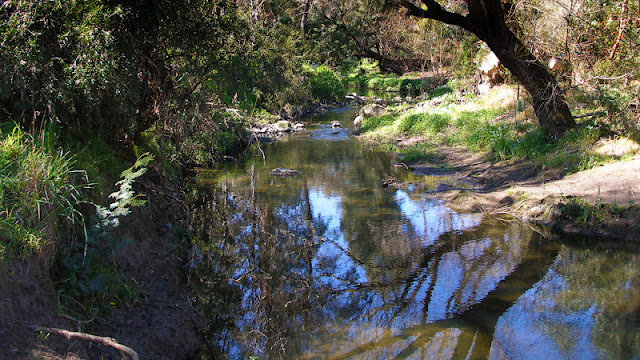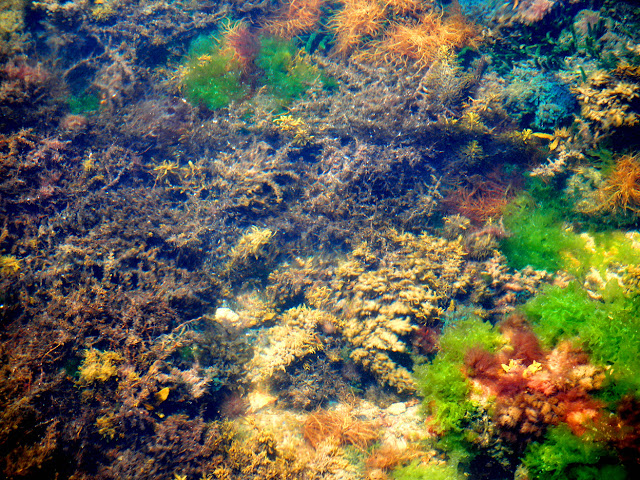RMIT University (officially the Royal Melbourne Institute of Technology) is an Australian public university located in Melbourne, Australia. RMIT University maintains three campuses in Victoria, Australia - City, Bundoora and Brunswick. It also operates a number of specialised "sites" - in metropolitan Melbourne and in rural Victoria.
RMIT Bundoora was established in 1995, and is an award-winning "country campus" of RMIT. It is RMIT's second oldest and second largest campus and is located in Bundoora, 20 km from the City campus. RMIT Bundoora is divided into two campuses by Plenty Road, known as East and West. The older West campus was the former site of the Phillip Institute of Technology, which amalgamated with RMIT in 1992. Unlike the urban RMIT City campus in Melbourne, the West campus is set in 42 ha of parklands and designed to be eco-friendly and sustainable.
While working there in the past I curated the Pathology Museum as part of my academic duties and I painted this mural which is still housed in the RMIT Pathology Museum on the Bundoora West Campus. The mural is a representation of the history of disease and its treatment through the ages and it shows important people and developments in disease and healing from ancient times to modern times. As well as being decorative, it stimulated the students to do some reading about the history of medicine.
This post is part of the Monday Murals meme.
Monday, 30 April 2012
Sunday, 29 April 2012
TREMONT, VICTORIA
Tremont is an outer suburb of Melbourne, Australia, 31 km south-east from Melbourne's central business district. Its Local Government Area is the Shire of Yarra Ranges. At the 2006 Census, Tremont had a population of 4094. Almost the entire suburban area is within the lush Dandenong Ranges National Park. The Post Office opened on 16 July 1913, known as Dunstan's until 1919, and closed in 1977. Tremont was affected by the Dandenong Ranges fire of January 22, 1997. However, since then the forest has regenerated.
We have friends living there and these photos were taken on their property, which is nestled in the forest. It is glorious living in such a beautiful natural setting, but the fear of bushfire is a constant worry.
This post is part of the Scenic Sunday meme.
We have friends living there and these photos were taken on their property, which is nestled in the forest. It is glorious living in such a beautiful natural setting, but the fear of bushfire is a constant worry.
This post is part of the Scenic Sunday meme.
Saturday, 28 April 2012
DAREBIN PARKLANDS
The Darebin Parklands straddle Alphington and Ivanhoe, approximately 10 kilometres northeast of the City of Melbourne, and they are a district park covering an area of 33 hectares. Darebin Creek flows through the Parklands, to join the Yarra River, at Alphington. The Darebin Parklands are highly regarded for its social, recreation, education, conservation, water quality management, cultural and heritage values.
The Parklands have a rich history as the homeland of the Wurundjeri Willam people and for cattle and sheep grazing, orchard and market garden use post European settlement. The southern section of the Darebin Parklands was developed as a bluestone quarry in 1890 and following the closure of the quarry in 1965, the land was leased to the Northcote Council as a municipal garbage tip which reached its capacity by 1975.
In the 1970’s the site was marked as a potential freeway or an area for industrial or residential development. Following this classification, local residents moved to protect the area and in 1973, formed the Rockbeare Park Conservation Group. The group pushed for the acquisition of land on the Alphington side and in 1975 the Whitlam Government funded the purchase of land for the park. A management committee was formed which included both adjoining Councils and community representatives. In 2001, the Darebin Parklands Committee of Management joined the Darebin Creek Co- ordinating Committee to form the Darebin Creek Management Committee. The Darebin Parkland’s rich history has contributed greatly to it being such a special and highly valued place today.
These Parklands are within walking distance of our house and we often go there to enjoy a piece of nature right in the middle of the City.
This post is part of James' Weekend Reflections meme.
The Parklands have a rich history as the homeland of the Wurundjeri Willam people and for cattle and sheep grazing, orchard and market garden use post European settlement. The southern section of the Darebin Parklands was developed as a bluestone quarry in 1890 and following the closure of the quarry in 1965, the land was leased to the Northcote Council as a municipal garbage tip which reached its capacity by 1975.
In the 1970’s the site was marked as a potential freeway or an area for industrial or residential development. Following this classification, local residents moved to protect the area and in 1973, formed the Rockbeare Park Conservation Group. The group pushed for the acquisition of land on the Alphington side and in 1975 the Whitlam Government funded the purchase of land for the park. A management committee was formed which included both adjoining Councils and community representatives. In 2001, the Darebin Parklands Committee of Management joined the Darebin Creek Co- ordinating Committee to form the Darebin Creek Management Committee. The Darebin Parkland’s rich history has contributed greatly to it being such a special and highly valued place today.
These Parklands are within walking distance of our house and we often go there to enjoy a piece of nature right in the middle of the City.
This post is part of James' Weekend Reflections meme.
LUNCH IN THE ROYAL ARCADE
Royal Arcade is a heritage shopping arcade in the central business district of Melbourne, Victoria. Originally constructed in 1869, the arcade connects Little Collins Street to the Bourke Street Mall, with a perpendicular passage running to Elizabeth Street in the west. It also connects to the smaller Hub Arcade near the Little Collins Street end.
Originally designed by Charles Webb, the arcade features a high glass roof and windowed stores. At the south end, the arcade features effigies of mythical figures Gog and Magog and a clock which chimes each hour. The arcade was restored between 2002-04 which resulted in additional natural light and consistency of the shopfronts. It is a significant Victorian era arcade, listed on the Victorian Heritage Register. In addition, Melbourne's Golden Mile heritage walk runs through the arcade.
This post is part of the Challenge Walk in the Streets meme.
Originally designed by Charles Webb, the arcade features a high glass roof and windowed stores. At the south end, the arcade features effigies of mythical figures Gog and Magog and a clock which chimes each hour. The arcade was restored between 2002-04 which resulted in additional natural light and consistency of the shopfronts. It is a significant Victorian era arcade, listed on the Victorian Heritage Register. In addition, Melbourne's Golden Mile heritage walk runs through the arcade.
This post is part of the Challenge Walk in the Streets meme.
Friday, 27 April 2012
MELBOURNE STREET TREES 17
Corymbia calophylla (also known as Eucalyptus calophylla R. Br.) is a bloodwood native to Western Australia. Common names include Marri and Port Gregory Gum, and a long standing usage has been Red Gum due to the red gum effusions often found on trunks. It is distinctive among bloodwoods for its very large buds and fruit (colloquially "honky nuts" in Western Australia). C. calophylla forms a natural group with two other Western Australian species C. ficifolia and C. haematoxylon.
Marri is widely distributed in the South-West of Western Australia, from north of Geraldton (28° S) to Cape Riche (34° S), and inland beyond Narrogin (32°56′S 117° E). It is found on the Swan Coastal Plain and on the Darling Scarp showing its adaptability to the different environments. It will grow on comparatively poor soil, but good specimens are considered an indicator of the better agricultural soils. It is seen in Melbourne streets and gardens where it makes for an impressive flowering gum specimen.
This post is part of the Floral Friday Fotos meme.
Marri is widely distributed in the South-West of Western Australia, from north of Geraldton (28° S) to Cape Riche (34° S), and inland beyond Narrogin (32°56′S 117° E). It is found on the Swan Coastal Plain and on the Darling Scarp showing its adaptability to the different environments. It will grow on comparatively poor soil, but good specimens are considered an indicator of the better agricultural soils. It is seen in Melbourne streets and gardens where it makes for an impressive flowering gum specimen.
This post is part of the Floral Friday Fotos meme.
Thursday, 26 April 2012
NORTH MELBOURNE TERRACE HOUSES
North Melbourne is a large inner city suburb of Melbourne, 2 km north-west from Melbourne's central business district. It is bounded by the CityLink freeway to the west, Victoria Street to the south, O'Connell and Peel Streets to the east and Flemington Road to the north. At the 2006 Census, North Melbourne had a population of 9,962.
Formerly known as Hotham, it was a working class area and was one of the first towns in Victoria to be granted municipal status. Today it continues to undergo gentrification, noted for its Victorian architecture, cosmopolitan demographic, commercial and older industrial areas. The rows of late 19th century terrace houses shown here were photographed around Dryburgh, Canning and Abbotsford Sts. The ornate iron lacework is a prominent feature of most Victorian terrace houses.
This post is part of Pat's Things in a Row meme.
Formerly known as Hotham, it was a working class area and was one of the first towns in Victoria to be granted municipal status. Today it continues to undergo gentrification, noted for its Victorian architecture, cosmopolitan demographic, commercial and older industrial areas. The rows of late 19th century terrace houses shown here were photographed around Dryburgh, Canning and Abbotsford Sts. The ornate iron lacework is a prominent feature of most Victorian terrace houses.
This post is part of Pat's Things in a Row meme.
Wednesday, 25 April 2012
MORNINGTON, VICTORIA
Mornington is a sea side town on the Mornington Peninsula, Victoria, located 57 km south-east of Melbourne's central business district. It is in the Local Government Area of the Shire of Mornington Peninsula. Mornington is known for its "village" atmosphere and its beautiful beaches. Mornington is a popular tourist destination with Melburnians who often make day trips to visit the area's bay beaches and wineries.
The Post Office opened on 21 May 1856 as Schnapper Point and was renamed Mornington in 1864. The town centre runs into the foreshore area and local beach, which features a yacht club, restaurant and park with playground facilities. Mornington is an attractive destination for shopping and features some excellent restaurants and cafes. The north of Mornington is also home to several horse breeders and stables.
This post is part of the Our World Tuesday meme,
The Post Office opened on 21 May 1856 as Schnapper Point and was renamed Mornington in 1864. The town centre runs into the foreshore area and local beach, which features a yacht club, restaurant and park with playground facilities. Mornington is an attractive destination for shopping and features some excellent restaurants and cafes. The north of Mornington is also home to several horse breeders and stables.
This post is part of the Our World Tuesday meme,
and also part of the Water World Wednesday meme,
and also part of the Nature Footsteps Waters meme,
and also part of the Outdoor Wednesday meme.
Subscribe to:
Posts (Atom)





















































